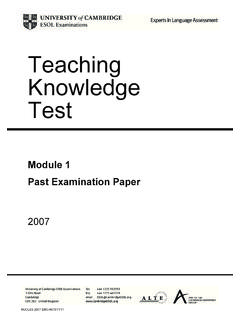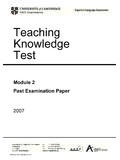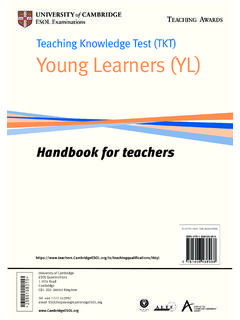Transcription of TKT Past Paper 2007 Module 1 - tkttw.com
1 Teaching Knowledge Test Module 1. past Examination Paper 2007 . UCLES 2007 EMC/4875/7Y11. Candidate Centre Number Number Candidate Name UNIVERSITY OF CAMBRIDGE ESOL EXAMINATIONS. English for Speakers of Other Languages TEACHING KNOWLEDGE TEST 001. Module 1 Version 07. Language and background to language learning and teaching 1 hour 20 minutes Additional materials: Answer sheets Soft clean eraser Soft pencil (type B or HB is recommended). TIME 1 hour 20 minutes INSTRUCTIONS TO CANDIDATES. Write your name, Centre number and candidate number in the spaces at the top of this page. Write these details on your answer sheet if they are not already printed. Do not open this booklet until you are told to do so. There are eighty questions in this Paper . Answer all questions. Mark your answers on the separate answer sheet.
2 Use a pencil. You may write on the question Paper , but you must mark your answers in pencil on the answer sheet. You will have no extra time for this, so you must finish in one hour and twenty minutes. At the end of the test, hand in both the question Paper and the answer sheet. INFORMATION FOR CANDIDATES. Each question in this Paper carries one mark. This question Paper consists of 14 printed pages and 2 blank pages. PV4. UCLES 2006 [Turn over 2. For questions 1-6, match the underlined words/groups of words in the text with the language terms listed A-G. Mark the correct letter (A-G) on your answer sheet. There is one extra option which you do not need to use. Language terms A word with affix B idiom C compound adjective D connector E phrasal verb F compound noun G word family Text My oldest brother is quite different from me he's a bit (1) old-fashioned really.]
3 I. suppose he's just very traditional. For example, he always wears (2) a suit, a tie and leather shoes, listens to the radio and plays cricket. But the worst thing is that he's got no sense of humour and that really (3) gets on my nerves. I also get the impression that he thinks I'm pretty (4) worthless, which doesn't help our relationship. We rarely see each other these days. He sometimes (5) calls in when he's in the area and then we may go out together. But we usually end up arguing about which (6) bus stop to walk to, or something silly like that. 3. For questions 7-13, match the underlined clauses with their meanings in the sentences listed A, B or C. Mark the correct letter (A, B or C) on your answer sheet. Meanings A condition B reason C result Clauses 7 It was such a bad film that we walked out.
4 8 I decided to go and see him since he hadn't phoned me. 9 I fell asleep in the car because I was so tired. 10 As there was no coffee left, I had a cup of tea. 11 I won't speak to him again unless he apologises. 12 As long as you can save the money yourself, you can go on the trip. 13 I walked into town so that I could avoid the traffic. [Turn over 4. For questions 14-19, choose the correct lexical or phonological terms to complete the sentences. Mark the correct letter (A, B or C) on your answer sheet. 14 Unhappy, disagree and incorrect include examples of A prefixes. B informal language. C synonyms. 15 Hole and whole; mail and male; by and buy are examples of A homophones. B unvoiced sounds. C false friends. 16 Put out; put off; put away are examples of A antonyms. B verb patterns. C multi-word verbs.]
5 17 Vehicle car, bicycle, plane; pet dog, cat, rabbit; food bread, pizza, meat are examples of A collocations. B lexical sets. C collective nouns. 18 Can't; don't; he's are examples of A connected speech. B weak forms. C contractions. 19 Fit and feet; fear and fair; track and truck are examples of A rhymes. B minimal pairs. C linking. 5. For questions 20-28, match the underlined letter a' in each example word with the phonemic symbols which would be used in a dictionary entry listed A, B, C or D. Mark the correct letter (A, B, C or D) on your answer sheet. You need to use some options more than once. Phonemic symbols A / /. B / e /. C / /. D /W/. Example words 20 late 21 player 22 party 23 alphabet 24 island 25 hard 26 pizza 27 grandson 28 invitation [Turn over 6. For questions 29-34, match the example sentences with the functions listed A-G.]
6 Mark the correct letter (A-G) on your answer sheet. There is one extra option which you do not need to use. Example sentences Functions 29 I can't decide whether this radio is worth buying or not. A expressing obligation 30 I'm going to visit my mother this afternoon. B expressing a preference 31 I'd rather have the blue one. C offering help D expressing an intention 32 If I finish the work earlier, can I get paid more? E predicting 33 You must fill in the form before the end of the month. F expressing doubt 34 Paula's got a chance of winning the race. G negotiating 7. For questions 35-40, look at the language skills and three possible descriptions of them. Two of the descriptions are appropriate in each situation. One of the descriptions is NOT appropriate. Mark the description (A, B or C) which is NOT appropriate on your answer sheet.
7 35 Productive skills involve A expressing rather than understanding language. B speaking and writing activities. C listening and reading tasks. 36 Re-drafting involves A copying a piece of writing out neatly. B doing a piece of writing for the second or third time. C making changes to a piece of writing. 37 Process writing involves A planning a piece of writing. B writing without editing. C using writing subskills. 38 Listening for gist involves A being able to understand every word of a text. B working out the overall meaning of a text without concentrating on the details. C forming a general idea of what a text is about. 39 Proofreading involves A checking for language errors. B reading your written work word by word. C paraphrasing parts of a text. 40 Speaking accurately involves A using the right expressions to convey meaning.
8 B using colloquial language to express ideas. C using lexis and structures correctly. [Turn over 8. For questions 41-46, match the classroom activities with the strategies for motivating learners listed A-G. Mark the correct letter (A-G) on your answer sheet. There is one extra option which you do not need to use. Classroom activities 41 At the start of the class, the teacher writes on the board what she hopes the learners will achieve in the lesson. 42 The teacher introduces a new topic by using situations from the learners' own lives. 43 The teacher gives only positive feedback on language used in an activity. 44 Students A and B exchange information in order to complete a text. 45 The teacher finds out how and when the learners like to be corrected. 46 The teacher shows the learners how to use the self-access centre.]
9 Strategies for motivating learners A Ask learners about their learning preferences. B Build up learners' confidence in their abilities. C Personalise lessons. D Make sure that learners understand instructions. E Encourage learner autonomy. F Make the learning aims clear to learners. G Give learners a reason for communicating with one another. 9. For questions 47-52, match what the student does with the learning strategies listed A-G. Mark the correct letter (A-G) on your answer sheet. There is one extra option which you do not need to use. Learning strategies A illustrating meaning B guessing from context C memorising D highlighting pronunciation features E focusing on collocations F predicting content from titles G consulting reference sources What the student does 47 I try to identify the part of speech from the other words in the sentence.
10 48 I make a note of the stress when I put words into my vocabulary notebook. 49 I try to listen out for new words in expressions, rather than individual words. 50 If I'm not sure what form to use, I look it up in a grammar book. 51 I sometimes draw timelines in my grammar notebook. 52 Occasionally, I test myself on recently taught words so I don't forget them. [Turn over 10. For questions 53-58, match the needs of each group of students with the most suitable type of course listed A-G. Mark the correct letter (A-G) on your answer sheet. There is one extra option which you do not need to use. Groups of students 53 These young adults need a range of study skills before going to a British university. 54 These adult beginners are going on holiday, and need to learn how to communicate in an English-speaking environment.]


